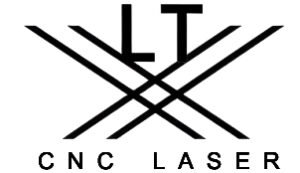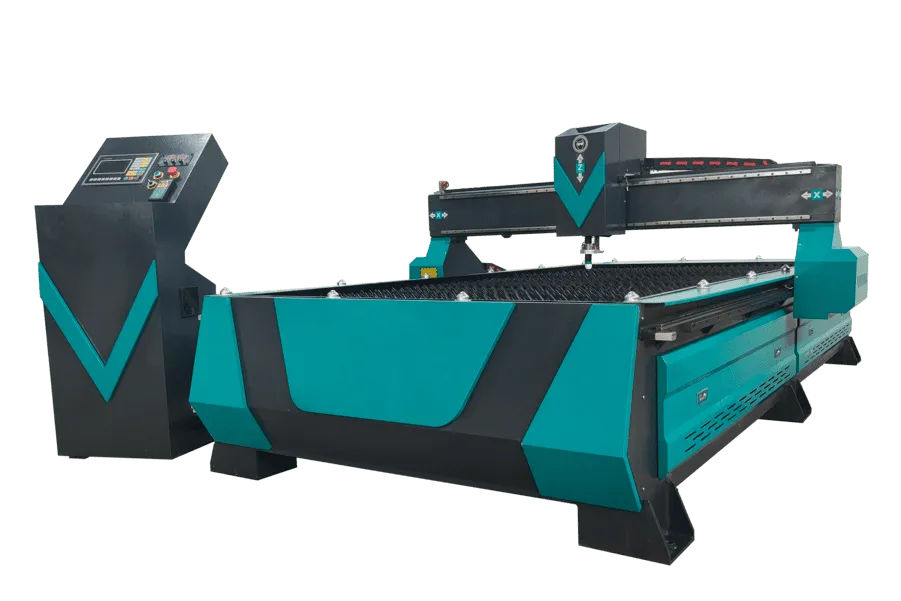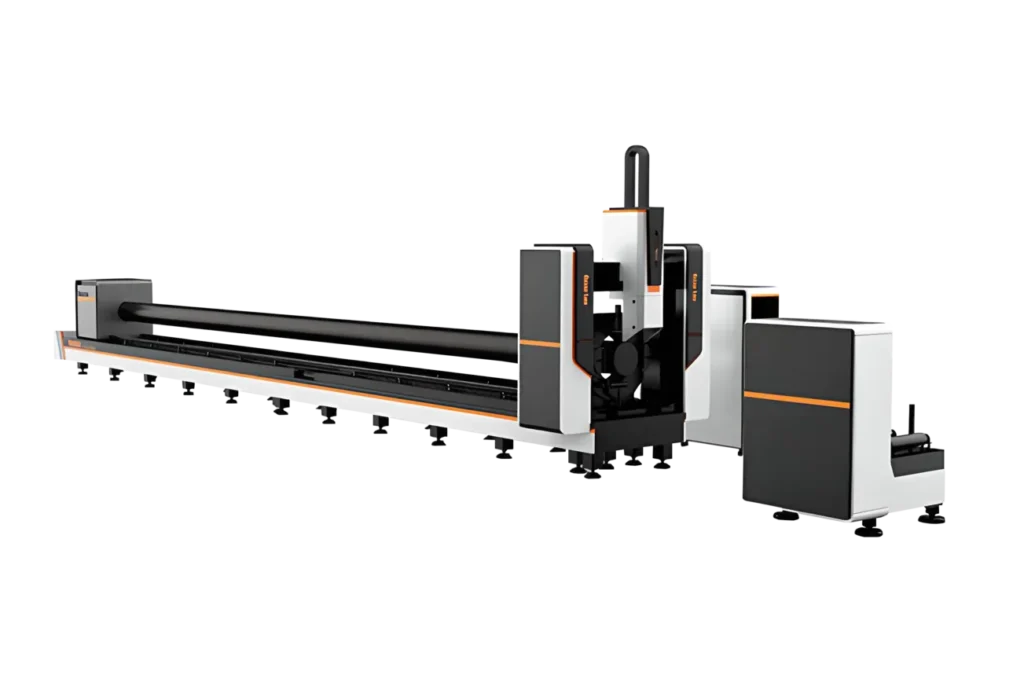CNC laser cutting machines utilize a high-energy laser beam focused on the workpiece surface to locally melt or vaporize the material, which is then rapidly removed, achieving non-contact cutting. Laser cutting features high cutting precision, fast processing speed, narrow kerfs, and a small heat-affected zone. Compared to traditional mechanical cutting, laser cutting can save material usage and improve processing efficiency. Fiber laser cutting machines, as a solid-state laser technology, further offer advantages such as compact structure, high energy efficiency, low maintenance costs, and the ability to cut highly reflective metals like copper. Compared to plasma cutting, fiber lasers can cut the same thickness at lower temperatures, resulting in smoother cuts. Compared to oxy-fuel flame cutting, laser cutting has a broader application scope, is not limited by material electrical conductivity, and offers significantly higher cutting precision.

Fiber Laser Cutting Machine
- High Precision and High Speed: The laser beam's focal point diameter is extremely small, enabling precise control of the cutting path with almost no need for post-processing; its concentrated energy ensures high efficiency for cutting thin sheets (e.g., 1mm).
- Process Flexibility: Laser cutting can achieve both flat and three-dimensional cutting (e.g., bevel cutting) without changing tools. It is suitable for complex contours and various metal materials, offering diverse and flexible processing forms.
- Low Consumption and Environmental Friendliness: Laser cutting is non-contact processing, eliminating the need for external force and reducing wear. Fiber lasers have high electro-optical conversion efficiency, resulting in low overall energy consumption. They also offer environmental advantages such as minimal dross and no smoke/dust.
In summary, fiber laser cutting machines are highly favored in modern manufacturing fields demanding high precision due to their excellent cutting quality and efficiency.
Current Status of the Chinese Laser Cutting Market
With the upgrading of the manufacturing industry and growing market demand, the scale of China's laser cutting equipment market continues to expand. According to Zhiyan Consulting statistics, China's laser cutting equipment market size was approximately 36.85 billion CNY in 2024 and is expected to exceed 40 billion CNY in 2025. Industry reports also show that the market size reached 32.75 billion CNY in 2023, a year-on-year increase of about 9.1%. In terms of equipment sales volume, according to Qianzhan Industry Research, China's laser equipment output exceeded 200,000 units in 2021, a year-on-year increase of 32.9%; the compound annual growth rate (CAGR) of total laser cutting sales from 2016 to 2020 was about 33.3%.
Chart 1. Statistical Data of China's Laser Cutting Equipment Market Size from 2013 to 2025. Industry research shows a long-term upward trend in market size, reaching approximately 36.85 billion CNY in 2024 and expected to exceed 40 billion CNY in 2025.
The competitive landscape of China's laser cutting market is currently highly differentiated: leading companies occupy the major market share. In 2024, the top five companies—Bodor Laser, HGTech, Han's Laser, HSG Laser, and Penta Laser—collectively accounted for about 40% of the revenue market share, with Bodor Laser leading (approx. 9.1%). In terms of shipment volume, Bodor Laser, HSG Laser, Han's Laser, and other manufacturers were among the top performers in 2023. Simultaneously, China's laser cutting equipment exports maintain strong growth: in 2023, the export value of laser processing equipment was about 13.759 billion CNY, significantly higher than the import value of 4.609 billion CNY. Shandong Province ranked first with an export value of 5.25 billion CNY. This export trend indicates that Chinese laser equipment is accelerating its penetration into overseas markets leveraging cost-performance advantages.
Intelligent Development Trends
With the advancement of Industry 4.0 and the "Made in China 2025" strategy, laser cutting equipment is rapidly evolving towards intelligence. Intelligent laser cutting integrates technologies such as Artificial Intelligence (AI), Internet of Things (IoT), and big data, enabling equipment to automatically adjust, monitor in real-time, and optimize production. Typical applications include:
-
AI-assisted Cutting: Using algorithms to automate cutting paths and process parameters, and detecting cutting quality through image recognition during the cutting process to achieve closed-loop control.
-
Machine Vision and Edge Computing: Integrating high-speed cameras and edge computing units on cutting heads and motion platforms to recognize workpiece position and defects in real-time, allowing adjustments without stopping the machine.
-
Intelligent Nesting and Digital Twins: Employing advanced nesting algorithms and digital simulation technology to simulate and optimize sheet cutting layouts, combined with virtual commissioning to shorten production preparation time.
-
Remote Monitoring and Diagnostics: Through cloud platforms and "Smart Cloud" systems, enabling remote fault diagnosis, online firmware upgrades, big data analysis of equipment, and visual monitoring.
-
AI Automation: Utilizing machine learning to train process parameters for different materials and thicknesses, automatically generating optimal cutting plans before startup, and correcting deviations online.
-
IoT Remote Monitoring: Laser cutting systems connected to the industrial internet can transmit production data in real-time. Combined with APP or web-based software, they monitor the operating status of each device, enabling full-process visual management.
-
Digital Twins and Predictive Maintenance: Some leading companies have developed digital twin models of equipment to predict the lifespan of cutting heads and optical components, issuing replacement reminders before parts reach critical values, thereby improving equipment utilization and reducing downtime risks.
It is foreseeable that future intelligent laser cutting will continuously enhance autonomous decision-making capabilities and full-process digitalization, transitioning from traditional single-device delivery to a "product + service" ecosystem model.
Automation Development Trends
The laser cutting industry is vigorously promoting the construction of automated production lines to increase capacity and reduce labor costs. Automatic loading/unloading systems have become standard: using robotic arms or pallet systems to automatically load and unload sheets, enabling long periods of unattended operation. For example, automatic coil production lines can automatically uncoil, level, cut, and collect materials, significantly improving coil processing efficiency.
-
Smart Material Warehouses and Rack Systems: Equipped with large warehouses for caching sheets, automatic sorting, and conveying systems, enabling one-click scheduling of steel plates of different thicknesses and specifications, enhancing workshop flexibility.
-
Unmanned Workshops and Multi-Machine Coordination: Multiple laser cutting machines cooperate with automated guided vehicles (AGVs), carts, etc., forming a closed-loop logistics system to achieve workshop-level unmanned production lines. Furthermore, laser cutting equipment is gradually being deeply integrated with MES/ERP systems. Factory management systems uniformly issue production tasks and collect processing data, enabling traceable production processes and efficiency optimization.
-
Automatic Loading/Unloading: Integrated automatic pallets, robotic arms, or shuttle tables enable continuous feeding and removal of materials without manual intervention.
-
Smart Material Warehouses: Building intelligent automated storage/retrieval systems (AS/RS) or coil warehouses, using automated retrieval and conveying systems for rapid material preparation, supporting batch production scenarios; some solutions already enable dual-head or triple-head laser cutting machines to work in parallel, further boosting capacity.
-
Unmanned Workshops: Connecting multiple laser cutting units, painting/welding equipment with automated logistics systems, supplemented by environmental monitoring and safety protection, forms highly automated smart factories.
Overall, automation upgrades not only improve production efficiency but also provide reliable support for large-volume, personalized customization, driving China's laser cutting production lines towards "high-density, large-scale" evolution.
Application Area Expansion
The application areas of laser cutting technology are continuously expanding, penetrating from traditional home appliances and machinery manufacturing into high-end fields like new energy, aerospace, and medical. In the automotive industry, laser cutting already covers the processing of key components such as body panels, chassis, and crash beams; according to industry data, 50%-70% of automotive parts are processed using lasers. Particularly, 3D five-axis laser cutting systems can flexibly process complex curved surfaces, such as roof brackets, windshield frames, and instrument panel openings. In the aerospace field, laser cutting enables high-precision cutting of titanium alloys and carbon fiber composite materials, used for aircraft fuselage skins, structural parts, and composite reinforcement parts, gradually replacing traditional milling and waterjet processes.
Demand in the new energy sector is surging: Laser cutting demonstrates advantages in applications such as new energy vehicle battery cases, fuel cell bipolar plates, and photovoltaic silicon wafers. Its high-speed, high-precision processing capabilities meet the requirements for lightweight and miniaturization. In medical devices, laser cutting can be used for micron-level processing of cardiovascular stents, orthopedic implants, etc. Its concentrated energy and minimal heat effect contribute to achieving burr-free and contamination-free cutting results. Furthermore, industries such as construction, agricultural machinery, boiler manufacturing, and kitchenware/hardware are also accelerating the introduction of laser cutting: for example, in construction for steel structures and curtain wall panel cutting, in agricultural equipment manufacturing for high-strength steel plate processing, and in household kitchen equipment production for stainless steel cabinet and panel cutting. Typical application cases include laser blanking of aircraft wing beams, laser cutting of new energy vehicle door crash beams, and micro-cutting of medical-grade stainless steel instruments. These cases demonstrate the broad prospects of laser technology in precision manufacturing.
Strategies for Brand Owners, Agents, and Importers
For brand owners and channel partners of laser cutting equipment, model selection and market entry need to balance technical barriers and cost-effectiveness.
- Selection Advice: Focus on laser source power, the maturity of the machine structure and control system; prioritize core technology manufacturers with independent intellectual property rights to avoid supply chain risks. For example, high-power fiber lasers are still mainly imported, with a localization rate of less than 40%, and technical barriers in the high-power sector are significant.
- Entry Strategy: New brands can target specific niche markets (e.g., high-power, micro-cutting, or large-format sheets), provide customized solutions, while strengthening R&D investment or pursuing mergers, acquisitions, and collaborations to enhance technical strength and competitiveness.
- Competitive Barriers: Upstream core optical components, CNC systems, and laser devices are major barriers, while the midstream and downstream markets emphasize brand marketing and service networks. Agents need to leverage brand advantages and capital strength to establish comprehensive after-sales service systems and professional teams.
- Profit Model: Brand owners primarily profit from whole machine sales and technical services; agents profit through value-added services such as spare parts supply, technical upgrades, and leasing. In recent years, the integrated ecosystem model of "equipment + software + service" has gradually emerged. It is recommended that channel partners invest in aftermarket services like big data, training, and maintenance to enhance customer stickiness.
Procurement and Operation Advice for End Users
End users should consider the Total Cost of Ownership (TCO) when purchasing laser cutting equipment: including equipment purchase price, consumable costs, maintenance costs, and downtime losses. Clarify energy consumption indicators, cutting efficiency, and lifecycle costs with suppliers, opting for models with higher cost performance.
- Operator Training: Manufacturers often provide basic training; users should also arrange for skilled operators to deeply learn cutting processes and maintenance knowledge to avoid human error. Establishing a cutting parameter database and operation manual is recommended for knowledge retention.
- Equipment Maintenance: Key components of laser cutting machines (e.g., laser head, focusing lens, galvanometer scanner, sealed gas path) require regular cleaning and calibration. Develop a preventive maintenance plan and maintain good repair records.
- After-Sales Service Assessment: Users can establish evaluation indicators such as repair response time, equipment availability rate, and warranty period, signing clear contracts with manufacturers. For long-term procurement and maintenance, consider signing service agreements with manufacturers or third-party service organizations to ensure prompt access to parts and technical support.
- In summary, good cost control and operational management maximize the return on investment in laser cutting.
Industry Chain Structure
Figure 2. Industry Chain Structure of the Laser Cutting Machine Sector. Upstream encompasses core components such as lasers, optical elements, and CNC systems. Midstream consists of whole machine manufacturers (e.g., Gweike, Xunlei, Jingzhong Optoelectronics, HGTech, Han's Laser, Chuangzhiyuan). Downstream applications span aerospace, automotive/shipbuilding, home appliance manufacturing, elevators, advertising, etc. Among these, fiber lasers and high-precision CNC systems are the "bottleneck" segments of the industry chain, which domestic manufacturers are intensively tackling. The diagram reflects the complete ecosystem of China's laser cutting industry chain, from components to whole machine manufacturing and application markets.
Representative Manufacturers and Solutions
Several representative enterprises have emerged in China's laser cutting market:
- Han's Laser: A domestic leader, offering a full range of fiber laser cutting machines from low-medium power to 100kW high power; developed multi-head, high-power cutting systems, and 3D five-axis automated lines.
- HGTech (Huagong Tech): Focuses on the mid-to-high-end market, possesses proprietary fiber laser technology, launched a 100kW ultra-high-power laser cutting machine; also developed digital integration solutions compatible with factory MES.
- Bodor Laser: A leading privately-owned enterprise in market share, renowned for medium-low power laser cutting machines. Its integrated automatic loading/unloading lines, dual-platform cutting machines, etc., offer high cost-performance and are actively expanding in North American and European markets.
- Gweike Laser (Jinweike): Excels in automation solutions, launching efficient and intelligent equipment such as automatic coil flexible production lines, smart warehouse systems, and automatic loading/unloading cutting machines, enabling unmanned factory production.
- Raycus Laser, Maxphotonics Laser: Major domestic fiber laser manufacturers, providing stable light sources for equipment manufacturers. Raycus has launched products above 10kW and is expanding into the ultrafast laser field.
- Ruidac Technology: A well-known cutting control system supplier. Its RDV8840G intelligent controller supports IoT functions, enabling cloud-based remote diagnosis and upgrades.
- Overseas Manufacturers: International giants such as Germany's Trumpf and Switzerland's Bystronic still hold significant influence in China's high-end market, with their products leading in ultra-high precision and system integration.
All manufacturers are investing in R&D for intelligence and automation, such as Gweike's automated production lines, Ruidac's IoT control systems, and HGTech's industrial internet platforms, providing users with integrated "equipment + software + service" solutions. The practices of these leading companies demonstrate that independent technology and system integration capabilities can effectively enhance production efficiency and build competitive barriers.
Sources: This report is based on publicly available industry reports, corporate materials, and market research data. Data cited from Zhiyan Consulting, industry research reports, and company-released information.
===== Page 5 =====
1 2 3 4 5 Laser Cutting vs. Other Cutting: Complete List - Baison
https://zh-cn.baisonlaser.com/blog/laser-cutting-vs-other-cutting/
6 9 23 2025 China Laser Cutting Machine Industry Market Size, Industry Chain, Competitive Landscape, Representative Enterprise Operating Status and Industry Development Trend Analysis: As an efficient and environmentally friendly processing tool, laser cutting machines have broad prospects [Chart]. Zhiyan Consulting
https://m.chyxx.com/industry/1219209.html
7 10 11 2023 China Laser Cutting Equipment Market: A Unique Market Leading in Both Scale and Output - OEShow
https://www.oeshow.cn/informationdetail/13139
8 pdf.dfcfw.com
https://pdf.dfcfw.com/pdf/H3_AP202211231580518315_1.pdf
12 14 15 19 20 21 22 2025 China Intelligent Laser Cutting Industry Analysis and Market Development Forecast - Chanelink Laser Network
https://www.chanelink.cn/news/468.html
13 RDV8840GT5 IoT Platform Laser Cutting Control System - Shenzhen Ruidac Technology Co., Ltd.
https://www.rdacs.com/product-detail/rdv8840gt5.html
16 Automated Laser Cutting Machine Solutions Make Unmanned Factories Possible. Laser Cutting Machine Laser Cutting Equipment Laser Cutting Machine Laser Cutting Machine Manufacturer - Jinan Gweike Laser Technology Co., Ltd.
https://www.gweike.com/lianxijinweike/xinwendongtai/280/
17 18 Laser Cutting Machine Application Solutions in Automotive Lightweighting — International Industrial Automation Network - An Internet Platform Focused on Automation and Digitalization
https://m.ilanews.com/ca/_01-ABC0000000000321869.shtml



